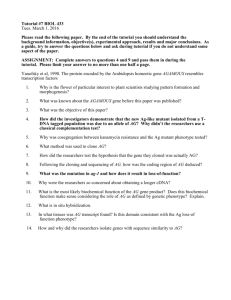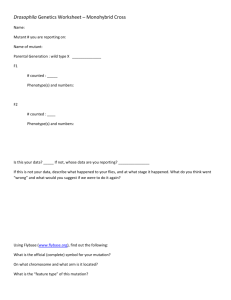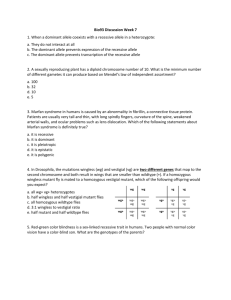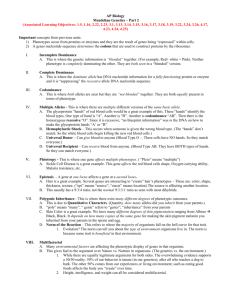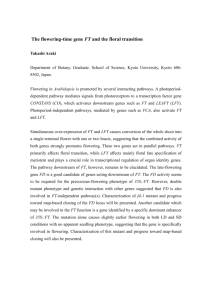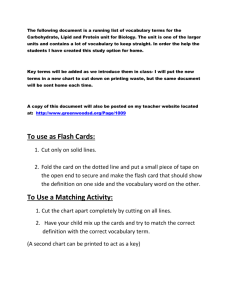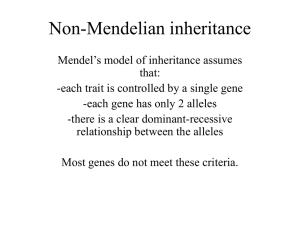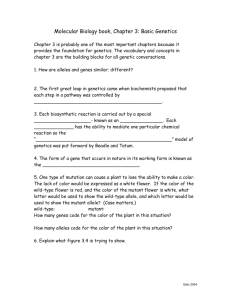Presentation Slides
advertisement
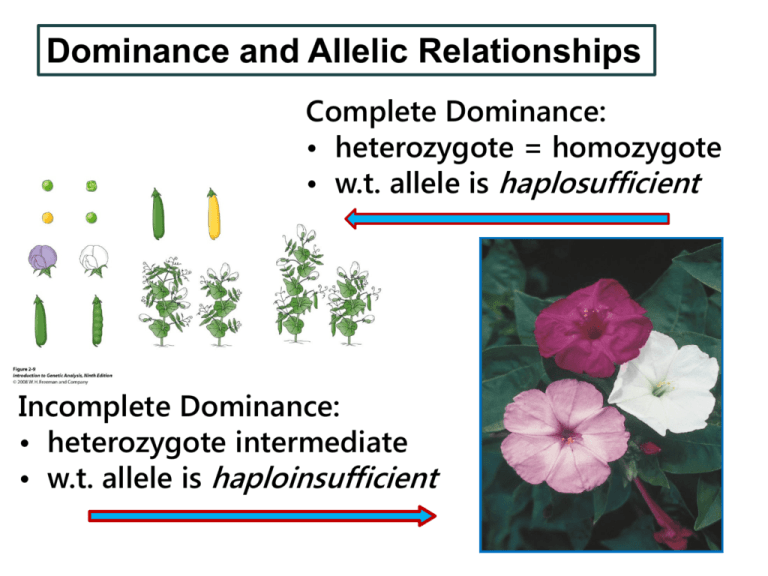
Dominance and Allelic Relationships Complete Dominance: • heterozygote = homozygote • w.t. allele is haplosufficient Incomplete Dominance: • heterozygote intermediate • w.t. allele is haploinsufficient Inheritance of incompletely dominant traits follows Mendelian principles Petal color in snapdragons: Red RR F1 F2 White rr Pink Rr 1/4 Red RR 1/2 Pink Rr 1/4 White rr Homozygous wild types and mutants express wild type and mutant phenotypes, respectively + = wild type m = null allele Figure 6-2 step 3 Expression in heterozygotes depends on haplosufficiency + = wild type m = null allele Null alleles of haplosufficient genes are recessive Figure 6-2 step 3 Null alleles of haploinsufficient genes may lead to intermediate expression or be dominant Haploinsufficiency Expression depends on effect of active allele Haploinsufficiency Heterozygosity for a null allele: Sled slows down = incomplete dominance Sled stops = dominant expression of null allele Null alleles of haploinsufficient genes may be dominant Haploinsufficiency Two active “wheel” alleles are necessary Null allele (missing wheel) is expressed as dominant Null alleles of haploinsufficient genes may be dominant Example: regulatory proteins Wildtype Conditions for dominance: • both wildtype alleles are necessary for any expression of phenotype − high threshold for phenotypic expression − no quantitative or intermediate expression Mutant Mutant Null alleles of haploinsufficient genes may be dominant W.t. allele produces 5 units of an enzyme, so that AA = 10 u, Aa = 5 u, aa = 0 u 5 units necessary for w.t. phenotype (low threshold), w.t. allele is haplosufficient AA = 10 u = wt null = recessive Wildtype Mutant Aa = 5 u = wt >5 units necessary for phenotype (high threshold), w.t. allele is haploinsufficient AA = 10 u = wt null = dominant Aa = 5 u = mut Mutant Review of Haploinsufficiency Expressed as incomplete dominance Expressed as dominant null allele Codominance: both alleles are expressed Blood types are examples of codominance ABO blood types are based on the presence of different genetically coded antigens on the surface of red blood cells IA IB i A antigen B antigen no antigen Codominance: both alleles are expressed AB blood type due to codominance of A and B antigens two alternate monogenic phenotypes (antigens) are expressed in the same individual IA IB = AB blood type Codominance in Blood Types alleles: IA = IB > i Blood Type Genotype A IA IA or IA i B IB IB or IB i AB IA IB only O i i only Match Babies with Parents Babies Parents O A B AB AB x O AxO A x AB OxO Codominance CRCR Red = White = CWCW Hybrid = CRCW Monohybrid: CRCR F1 CW CW CRCW F2 ¼ CRCR ½ CRCW ¼ CWCW Codominant expression of petal pigment in a Camellia Codominance CRCR Red = White = CWCW Hybrid = CRCW Not: Codominant expression of petal pigment in a Camellia True-breeding Parent 1 True-breeding Parent 2 F1 selffertilized F1 F2 103 213 99 Expression of dominance depends on how phenotype is defined Many traits exhibit complete, incomplete and codominance Sickle cell anemia is one of them Sickle cell anemia is codominant at the protein level Expression of Dominance for Sickle Cell Anemia Expression in: Genotype Individual Red Blood Cell Protein HbA/HbA normal normal HbA/HbS normal partial sickle A and S HbS/HbS anemic sickling A only S only Mendel’s peas showed three forms of dominance (although Mendel did not know it) W = branching enzyme produces amylopectin w = null mutation produces amylose Amylopectin Starch Grains Amylopectin + Amylose Amylose Round when dry Wrinkled when dry Expression of Dominance for Seed Shape Expression in: Genotype Seed Starch Grains Starch W/W round expanded AP only W/w round intermediate AP + A w/w wrinkled shrunken A only Dominant mutations often act as recessive lethals: homozygotes die Pleiotropy – multiple effects from one gene M+ / M M+/ M+ M/M Inheritance of recessive lethals Curly Curly 2/3 Curly, 1/3 wildtype Explanation: All Curly = Cy/Cy+, due to homozygous (Cy/Cy) lethality: Cy Cy+ Cy Cy / Cy Cy / Cy+ Cy+ Cy / Cy+ Cy+ / Cy+ dies Curly Curly Wildtype 2/3 of surviving offspring are Curly 1/3 are wildtype Other examples of pleiotropy: recessives for which a single mutation has harmful effects in different tissues • Aboriginal New Zealanders • single mutation causes both sterility and respiratory difficulties • the mutation alters a protein required for normal function of cilia and flagella • Northern, Central European descent - cystic fibrosis • poor respiration and lung disease, sterility, obstruction of small intestine • formation of thick mucus due to mutation in cell membrane channel protein Multiple Alleles: A single gene may have many alleles with different phenotypes The white eye color gene in Drosophila has different alleles that resemble each of the monogenic phenotypes shown above in a different fly species. Different alleles of white eyes (w) • different phenotypes • may be similar to mutations in other genes wcf ≈ sepia wBwx ≈ brown wc ≈ vermillion Test for Allelism in Diploids – same gene or different genes? Mutant 1 Mutant 2 F1 Mutant Mutations are allelic – same gene wcf/wcf wa/Y wcf/wa F1 “coffee” eyes “apricot” eyes non-wildtype F1 female carries two different mutant alleles in the same gene and is mutant Test for Allelism in Diploids – same gene or different genes? Mutant 1 Mutant 2 F1 Wildtype Mutations complement – different genes wc/wc; v+/v+ w+/Y; v/v “crimson” eyes “vermilion” eyes F1 w+/wc; v+/v wildtype F1 is heterozygous for mutations in each gene and is wildtype Multiple Alleles in Mammalian Coat Color: C = black/brown pigment cch = chinchilla ch = himalaya c = albino ch - an example of conditional temperature sensitive allele Conditional temperature sensitive effects on ch Near body temp Tyrosinase inactive No pigment Below body temp Tyrosinase active Dark pigment Comparison between Temperature-Sensitive Conditional, Genotype X Environment Interaction Temperature Sensitive phenotype repeatably modifiable after development complete ex: shts, ch G x E Interaction one time effect phenotype not modifiable after development complete Multigene Effects and Interactions Genes work in pathways anabolic, catabolic Most genes affect more than one character; more than one gene affects most characters Mutations block steps in pathways, cause mutant phenotypes G. Beadle and E. Tatum • studied Neurospora (bread mold) • genetics of biochemical pathways • isolated three mutant strains • deficient in biochemical pathway for argenine synthesis Microbe Nutrition and Growth Wildtype microbes synthesize their own amino acids and vitamins if the necessary precursors are available (carbon source, inorganic salts) • can produce colonies on minimal medium Microbes with nutritional mutations cannot synthesize essential nutrients • cannot produce colonies on minimal medium Mutant microbes can produce colonies on medium supplemented with the missing essential nutrient Microbial Mutant Screen Mutants and wildtypes can grow Only wildtypes can grow G. Beadle and E. Tatum Isolated three mutations • blocked synthesis of the amino acid argenine • were nonallelic – assorted independently B & T tested growth (+/-) on different potential intermediates in the argenine synthesis pathway • discovered differences between the mutants Potential intermediates in the argenine synthesis pathway Each mutant grew on a different combination of supplements Beadle and Tatum’s Interpretation arg-1 Precursor arg-2 Orn arg-3 Cit Arg Biochemical Pathways: a general model Precursor (upstream end) enzyme A gene a+ (or A) Intermediate enzyme B gene b+ (or B) Product (downstream end) Biochemical pathways usually have many steps Precursor enzyme A gene a+ enzyme B gene b+ enzyme C gene c+ enzyme D gene d+ enzyme E gene e+ Intermediate 1 Intermediate 2 Intermediate 3 Intermediate 4 Product Microbiol. Mol. Biol. Rev. March 2007 71:36-47 Tryptophan synthesis in prokaryotes: An example of a multistep biochemical pathway controlled by different genes trpF Genetic analysis of biochemical pathways in microbes and prokaryotes Five different groups of mutants were isolated. Their growth patterns on different supplements (intermediates) are shown below: Mutant Sup A Sup B Sup C Sup D Sup E Sup F Grp 1 + - - + + + Grp 2 - - - + - + Grp 3 + - + + + + Grp 4 - - - + + + Grp 5 - - - - - + Determine the order of the intermediates in the biochemical pathway and the mutant that controls each step 3 B 1 C 4 A 2 E 5 D F Test for Allelism in Diploids and Basis for Gene Interaction Mutant 1 Mutant 2 F1 = Mutant Mutations are allelic – same gene Mutant 1 Mutant 2 F1 = Wildtype Mutations are in different genes In each case, mutant 1 and mutant 2 may have the same or different phenotypes • If mutant 1 and mutant 2 are in different genes and affect the same character • Then they may interact to produce a modified 9:3:3:1 ratio in the F2 Mutations are in the same gene Mutations are in different genes affecting the same character Interaction modifies 9:3:3:1 ratio A biochemical pathway for complementary protein coding genes w1 w2 Generalized Biochemical Pathway: petal pigmentation as an example Precursor: no pigment = white enzyme A gene a+ Intermediate: no pigment = white enzyme B gene b+ Product: blue pigment Generalized Biochemical Pathway: effects of mutations Precursor: no pigment = white enzyme A gene a mutant = white Intermediate: no pigment = white enzyme B Phenotype: white gene b+ Generalized Biochemical Pathway: effects of mutations Precursor: no pigment = white enzyme A gene a+ Intermediate: no pigment = white enzyme B Phenotype: white gene b mutant = white Generalized Biochemical Pathway: effects of mutations Precursor: no pigment = white enzyme A gene a Intermediate: no pigment = white enzyme B Phenotype: white gene b Independent Assortment AABB aabb or AAbb produces AaBb aaBB Independent assortment in the F2 produces (- = indeterminate): AAaa aa Bbb Bbb 3/4 x 3/4 = 9/16 3/4 x 1/4 = 3/16 1/4 x 3/4 = 3/16 1/4 x 1/4 = 1/16 Dihybrid Ratios are Modified by Complementation AABB aabb or AAbb aaBB produces AaBb F1 F2 produces: A- B- = 9/16 A- bb = 3/16 aa B- = 3/16 aa bb = 1/16 9/16 wildtype 7/16 mutant Complementation: an interaction between two genes that are both necessary for expression of a phenotype Dihybrid F2 9/16 = +/- +/3/16 = +/- / 3/16 = / +/1/16 = / / blue white Interaction between a regulatory protein and its target can also produce complementation: both genes are necessary for expression of the phenotype Interaction between a regulatory gene and its target Figure 6-18 step 4 Intermediate elements of a biochemical pathway may have a distinct phenotype Biochemical Pathway: Petal Pigmentation Precursor: no phenotype = white enzyme 1 allele w+ Intermediate: pink pigment enzyme 2 Product: blue pigment allele m+ Biochemical Pathway: Petal Pigmentation Precursor: no phenotype = white enzyme 1 allele w+ Intermediate: pink pigment enzyme 2 Phenotype: pink allele m mutant = pink Biochemical Pathway: Petal Pigmentation Precursor: no phenotype = white enzyme 1 allele w mutant = white Intermediate: pink pigment enzyme 2 Phenotype: white allele m+ Biochemical Pathway: Petal Pigmentation Precursor: no phenotype = white enzyme 1 allele w mutant = white Intermediate: pink pigment enzyme 2 Phenotype: white allele m mutant = N/A Modified Dihybrid Ratio with Recessive Epistasis AABB aabb or AAbb aaBB produces AaBb F1 F2 produces: A- B- = 9/16 A- bb = 3/16 aa B- = 3/16 aa bb = 1/16 9/16 wildtype - blue 3/16 mutant2 - pink 4/16 mutant1 - white (colorless) Coat color genes interact epistatically: B and C genes in mammals B/-; C/- b/b; C/- -/-; c/c Recessive epistasis: recessive phenotype for C gene masks genotypic variation for B gene – – Expressed gene is epistatic to the masked gene (C is epistatic to B ) Biochemical Pathway: Black Coat Precursor: no pigment enzyme “C” Intermediate gene C brown pigment enzyme “B” Phenotype: black coat gene B blocked in brown coat www.adapaproject.org/doggenetics/ Modified Dihybrid Ratio with Recessive Epistasis CCBB black ccbb or CCbb albino brown ccBB albino produces CcBb (black) F1 F2 produces: C- B- = 9/16 C- bb = 3/16 cc B- = 3/16 cc bb = 1/16 9/16 black 3/16 brown 4/16 albino Coat color genes interact epistatically: B and E genes in mammals B/-; E/- b/b; E/- -/-; e/e B/-; E/- b/b; E/- -/-; e/e Several crosses in which yellow dogs were mated to brown ones produced all black in the F1. – What were the genotypes of the parents and the F1? – What would be the phenotypic ratio in the F2 ? Foxgloves illustrate different kinds of gene interactions and modification of Mendelian ratios Dominant Epistasis A dominant allele of one gene masks allelic variation in another gene -/-; W/- d/d; w/w D/-; w/w M - anthocyanin synthesis D - modifier of M W - prevents deposition of pigment Modified Dihybrid Ratio with Dominant Epistasis WWDD wwdd or WWdd produces WwDd F1 wwDD Intercross F1 produces F2 : W- D- = 9/16 12/16 white W- dd = 3/16 3/16 purple ww D- = 3/16 1/16 lavender ww dd = 1/16 Recessive Epistasis M - anthocyanin synthesis D - modifier of M W - prevents deposition of pigment M/M; D/D purple m/m; d/d white F1 = all purple F2 = 9/16 M/-; D/3/16 M/-; d/d 3/16 m/m; D/1/16 m/m; d/d purple lavender white Suppression: one gene can suppress the expression of another gene • Dominant Suppression • Dominant suppressor reverses the dominant (wildtype) expression of another gene to a mutant expression • Recessive Suppression • Recessive suppressor reverses the recessive (mutant) expression of another gene to a wildtype expression • Both are characterized by 13:3 ratios in the F2 Modified Dihybrid Ratios with Suppression Dominant Suppression: Recessive Suppression: M = purple petal exterior, m = white W = prevents pigment deposition pd+ = wildtype eyes, pd = purple eyes su = recessive suppressor of pd Partial F2 Genotype Flower Petal Phenotype Partial F2 Genotype Eye Color Phenotype 9/16 W/-; M/- white 9/16 pd+/-; su+/- wildtype 3/16 W/-; m/m white 3/16 pd+/-; su/su wildtype 3/16 w/w; M/- purple 3/16 pd/pd; su+/- purple 1/16 w/w; m/m white 1/16 pd/pd; su/su wildtype Modified Dihybrid Ratios with Suppression Dominant Suppression: Recessive Suppression: M = purple petal exterior, m = white W = prevents pigment deposition pd+ = wildtype eyes, pd = purple eyes su = recessive suppressor of pd Partial F2 Genotype Flower Petal Phenotype Partial F2 Genotype Eye Color Phenotype 9/16 W/-; M/- white 9/16 pd+/-; su+/- wildtype 3/16 W/-; m/m white 3/16 pd+/-; su/su wildtype 3/16 w/w; M/- purple 3/16 pd/pd; su+/- purple 1/16 w/w; m/m white 1/16 pd/pd; su/su wildtype Modified Dihybrid Ratios with Suppression Dominant Suppression: Recessive Suppression: M = purple petal exterior, m = white W = prevents pigment deposition pd+ = wildtype eyes, pd = purple eyes su = recessive suppressor of pd Partial F2 Genotype Flower Petal Phenotype Partial F2 Genotype Eye Color Phenotype 9/16 W/-; M/- white 9/16 pd+/-; su+/- wildtype 3/16 W/-; m/m white 3/16 pd+/-; su/su wildtype 3/16 w/w; M/- purple 3/16 pd/pd; su+/- purple 1/16 w/w; m/m white 1/16 pd/pd; su/su wildtype Phenotype modified by suppression Modified Dihybrid Ratios with Suppression Partial Genotype 9 A - ; Su - Dominant Suppression (3 wt: 13 mut) Mutant Recessive Suppression (13 wt: 3 mut) Wildtype 3 A - ; su su Wildtype Wildtype 3 a a ; Su - Mutant Mutant 1 a a ; su su Mutant Wildtype Phenotype modified by suppression Modified Dihybrid Ratios with Suppression Partial Genotype 9 A - ; Su - Dominant Suppression (3 wt: 13 mut) Mutant Recessive Suppression (13 wt: 3 mut) Wildtype 3 A - ; su su Wildtype Wildtype 3 a a ; Su - Mutant Mutant 1 a a ; su su Mutant Wildtype Phenotype modified by suppression A cross with dominant suppression true white A/A; B/B true white a/a; b/b F1 = all white A/a; B/b F2 = 9/16 A/-;white B/mostly 3/16 A/-; b/b some purple 3/16 a/a; B/1/16 a/a; b/b white purple white Analysis of Gene Interactions: If the biochemical mechanism for the interaction is known, the ratio of partial genotypes and phenotypes can be determined If the phenotypic ratio is known, the mechanism for the interaction can be determined Interactions of genes in pathways: Complementation 9:7 F2 Recessive Epistasis 9:3:4 F2 disk long, F1 = all disk F2 = 32 long 178 sphere 270 disk Interactions between Phenotypes of Genes in Different Pathways Precursor Int Product A A+B Precursor Int Product B Products from two pathways are added together or superimposed. This interaction produces a 9:3:3:1 F2 ratio that includes novel phenotypes not present in parents or F1. black orange F1 = camouflage F2 = 9 3 3 1 camouflage orange black pink (albino) o+/-;b+/- o/o;b+/- o+/-;b/b o/o;b/b brown vermilion F1 = red (wildtype) F2 = 9/16 3/16 3/16 1/16 wildtype brown vermilion white vermilion white brown wildtype Interacting mutations affect eye color in Drosophila Figure 1-9 part 5 • Multiple genes affect eye color • Some of the genes interact • White eyes can be caused by more than one genotype (w orcn bw) Black Agouti black cinnamon B/-; a/a = black B/-; A/- = agouti F1 = all agouti F2 = 9 3 3 1 agouti black cinnamon brown b/b; A/- = cinnamon b/b; a/a = brown Modifier Genes (D gene) Chestnut Palomino Cremello Chestnut Series Bay Buckskin Bay Series Perlino Mammalian Coat Color Genes A gene: B gene: C gene: D gene: yellow band present or absent black vs. brown pigment presence or absence of pigment modifier, incomplete dominance E gene: deposition of pigment in fur S gene: SP = white patches Human Eye Color Variation blue – brown polymorphism: HERC2 regulatory gene effects expression of the OCA2 gene in iris – brown = full OCA2 expression – blue = very low OCA2 expression blue/gray variation due to different light scattering by the iris – there are no blue, gray (or green) pigments albino: mutant OCA2 gene (no pigment expression, not limited to eyes) Interaction between HERC2 and OCA2 HERC2 regulatory gene effects expression of the OCA2 gene in iris brown = full OCA2 expression blue = very low OCA2 expression HERC2 OCA2 melanin both genes are necessary for expression of the melanin pigments in iris Human Eye Color Variation brown polymorphisms (dark brown to green) controlled by interactions among 16 genes controlling pigment deposition, including HERC2 and different alleles of OCA2 – green = light brown + scattering (like blue) – hazel = light brown + different pigmentation patterns within the iris a ring of pigment in the iris can cause apparent eye color changes as the pupil dilates or in different light Red is normal petal pigmentation, orange and white are variants found in nature Parents F1 F2 red x white red 101 red, 33 white red x orange red 192 red, 63 orange orange x white red 272 red, 121 white, 89 orange
